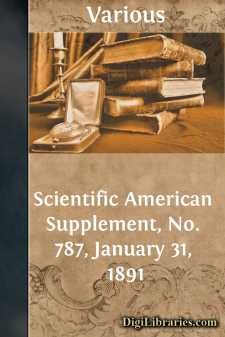Categories
- Antiques & Collectibles 13
- Architecture 36
- Art 48
- Bibles 22
- Biography & Autobiography 813
- Body, Mind & Spirit 142
- Business & Economics 28
- Children's Books 14
- Children's Fiction 11
- Computers 4
- Cooking 94
- Crafts & Hobbies 4
- Drama 346
- Education 46
- Family & Relationships 57
- Fiction 11829
- Games 19
- Gardening 17
- Health & Fitness 34
- History 1377
- House & Home 1
- Humor 147
- Juvenile Fiction 1873
- Juvenile Nonfiction 202
- Language Arts & Disciplines 88
- Law 16
- Literary Collections 686
- Literary Criticism 179
- Mathematics 13
- Medical 41
- Music 40
- Nature 179
- Non-Classifiable 1768
- Performing Arts 7
- Periodicals 1453
- Philosophy 64
- Photography 2
- Poetry 896
- Political Science 203
- Psychology 42
- Reference 154
- Religion 513
- Science 126
- Self-Help 84
- Social Science 81
- Sports & Recreation 34
- Study Aids 3
- Technology & Engineering 59
- Transportation 23
- Travel 463
- True Crime 29
Scientific American Supplement, No. 787, January 31, 1891
by: Various
Categories:
Description:
Excerpt
STEAM ENGINE VALVES.
By THOMAS HAWLEY.
In considering the slide valve in its simple form with or without lap, we find there are certain limitations to its use as a valve that would give the best results. The limitation of most importance is that its construction will not allow of the proper cut off to obtain all the benefits of expansion without hindering the perfect action of the valve in other particulars. At this economical cut off the opening of the steam port is very little and very narrow, and although this is attempted to be overcome by exceedingly wide ports, sixteen inches in width in many cases in locomotive work, this great width adds largely to the unbalanced area of the valve. The exhausting functions of the valve are materially changed at the short cut off, and when much lap is added to overcome this defect, there usually takes place a choking of the exhaust port. You might inquire, why not make the port wider, but this would increase the minimum amount of load on the valve, and this must not be overlooked. Then the cut off is a fixed one, and we can govern only by throttling the pressure we have raised in the boiler or by using a cut off governor and the consequent wastes of an enormous clearance space. You will observe, therefore, that the plain slide valve engine gives the most general satisfaction at about two-thirds cut off and a very low economic result. The best of such engines will require forty-five to fifty pounds of steam per horse power per hour, and to generate this, assuming an evaporation of nine pounds of water to a pound of coal, would require between five and six pounds of coal per horse power per hour. And the only feature that the valve has specially to commend it is its extreme simplicity and the very little mechanism required to operate it.
Yet this is of considerable importance, and in consideration of some special features at its latest cut off, the attempt has been many times made to take advantage of these features. For instance, at 90° advance, the valve opens very rapidly indeed and fully satisfies our requirements of a perfect valve. This is one good point, and in this position also the exhaust and compression can be regulated very closely and as desired without much lap, and as the opening of the exhaust port comes with the eccentric at its most rapid movement the release is very quick and as we would have it. This is only possible at the most uneconomic position of the valve as regards cut off.
The aim of many engineers has been to take advantage of these matters by using the valve with 90° angular advance of eccentric ahead of crank, for the admission, release, and compression of the steam, and provide another means of cutting off, besides the one already referred to, viz., cutting off the supply of steam to the chest, and overcome the objection in this one of large clearance spaces. This is done by means of riding cut off valves, often called expansion valves, of which, perhaps, the most widely known types in this vicinity are the Kendall & Roberts engine and the Buckeye....












